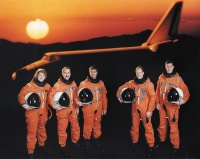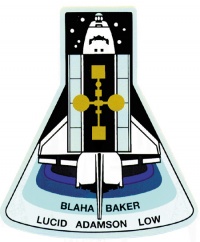STS-43
From The Space Library
 | |
| Organization | NASA-Office of Space Flight (United States) |
|---|---|
| Mission type | Earth Science,Human Crew,Solar Physics |
| Launch date | August 2, 1991 |
| Launch vehicle | Space Shuttle |
| Launch site | Cape Canaveral, United States |
| COSPAR ID | 1991-054A |
| Inclination | 28.45 degrees |
| Experiments | Here |
| Alternate Names | 21638 |
| Additional Information | Here |
| Data Collection | Here |
| Payload Mass Up | 21265 kg |
| Payload Mass Down | 4200.91 kg |
| Orbiter | Atlantis |
| Lift Off Mass | 2,057,494.55 kg |
| Orbiter Weight at Liftoff | 117,900.91 kg |
| Orbiter Weight at Landing | 89,425.00 kg |
| Landed | Runway 15 at Kennedy Space Center, Fla. |
| Orbits of Earth | 142 |
| Orbital Altitude | 160 nautical miles (184 statute miles) |
Contents |
[edit] Crew
- Commander: John E. Blaha
- Pilot: Michael A. Baker
- Payload Commander:
- Mission Specialist 1: Shannon W. Lucid
- Mission Specialist 2: G. David Low
- Mission Specialist 3: James C. Adamson
- Mission Specialist 4:
- Mission Specialist 5:
- Payload Specialist 1:
- Payload Specialist 2:
ISS/Mir Crew Transport
[edit] Mission
STS-43 was the ninth shuttle Atlantis flight. It's mission was to deploy a NASA communications satellite and to conduct a bevy of scientific experiments. The five-person crew consisted of John E. Blaha, Commander; Michael A Baker, pilot; Shannon W. Lucid, G. David Low and James C. Adamson, mission specialists. The cargo bay held the Tracking and Data Relay Satellite (TDRS), and experimental heat pipe element, an ultraviolet experiment and instruments for optical communications. Eight commercial crystal growth, materials processing, photographic, fluids and microgravity experiments were housed on the middeck. TDRS was dispatched from the cargo bay on orbit five, 6 hrs, 13 mns into the flight. The crew spent the remaining seven days conducting technology experiments and biomedical research. The entire flight from liftoff to landing progressed like virtual clockwork. Atlantis returned to earth on KSC's 15,00-ft concrete runway 15, at 12:23, August 11, to end the 8-day, 21-hr, 21-mn mission.
[edit] EVA
[edit] Payload
Tracking and Data Relay Satellite (TDRS)-E/lnertial Upper Stage (lUS); Space Station Heatpipe Advanced Radiator Element (SHARE)-ll; Shuttle Solar Backscatter Ultraviolet (SSBUV) instrument 03; Optical Communications Through the Shuttle Window (OCTW); Air Force Maui Optical Site (AMOS) Calibration Test; Auroral Photography Experiment (APE)-B; Bioservelnstrumentation Technology Associates Materials Dispersion Apparatus (BlMDA)-02; Investigations Into Polymer Membrane Processing (IPMP)-03; Protein Crystal Growth Ill Block Il; Space Acceleration Measurement System (SAMS); Solid Surface Combustion Experiment (SSCE)-02; Tank Pressure Control Experiment (TPCE)
[edit] Books about the Space Shuttle Program
Buy This Book Click here |
Buy This Book here |
Buy This Book Click here |
Buy This Book Click here |





